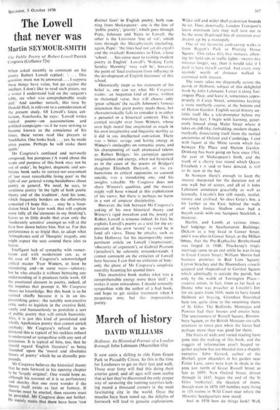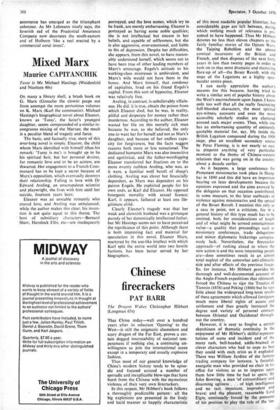• March of history
DAVID WILLIAMS
Holborn: An Historical Portrait of a London Borough John Lehmann (Macmillan 65s)
It now costs a shilling to ride from Green Park to Piccadilly Circus. So this is the time for Londoners to get on their feet and walk. Those over forty will find this doing their arteries good; and all ages will soon realise that at last they've discovered the only proper way of savouring the teeming surprises lurk- ing round a thousand corners in the most fascinating city in the world. Once the muscles have been toned up, the delights of footwork will lead to genuine explorations.
Wider still and wider shall pedestrian bounds be set. Thus, deservedly, London Transport's latest minimum fare may well turn out to be the most ill-advised bits of extortion ever dreamt up by a monopoly.
One of my favourite cash-saving walks is from Regent's Park to Printing House Square. 1 his takes lifty-live minutes, allow- ing for hold-ups at traffic lights—twenty-five minutes longer, say, than it would take if I paid to have myself carried. And every sixty seconds' worth of distance walked is crammed with interest.
The route takes me diagonally across the jiarish of Holborn, subject of this delightful book by John Lehmann. I enter it along Tor- rington Place. and leave it, sometimes appro- priately in Carey Street, sometimes keeping a more northerly course, at the bottom end of Hatton Garden. English social history un- folds itself like a tele-prompter before my marching feet. I begin with learning, gener- ously housed along Malet Street where it takes on cliff-like, forbidding, modern shapes, markedly dissociating itself from the storied ancientries of Oxford and Cambridge. 1 end with liquor at the Mitre tavern which lies between Ely Place and Hatton Garden. Drinking has been going on here since 1564, the year of Shakespeare's birth, and the trunk of a cherry tree round which Queen Elizabeth i is said to have danced, is still to be seen in the bar.
In between there's enough to keep the interest sharpened for the duration not of one walk but of scores, and all of it John Lehmann annotates gracefully as well as learnedly. Lincoln's Inn still stands, restful, roomy and civilised. So does Gray's Inn, a bit farther to the East, behind the walls of which Justice Shallow once had a boyish tussle with one Sampson Stockfish, a fruiterer.
Hazlitt. and Lamb, at various times. had lodgings in Southampton Buildings: Dickens as a boy lived in Gower Street, and it was also in Gower Street. at the Millais 4IAUse, that the Pre-Raphaelite Brotherhood was forged in 1848; Thackeray's tragic marriage came to an end while he was living in Great Coram Street; William Morris had business premises in Red Lion Square; Lytton Strachey and the Bloomsbury (-Mack quipped and rhapsodised in Gordon Square which admittedly is outside the parish, but only by the width of Torrington Place— creative artists, in fact, from as far back as Donne who was preacher at Lincoln's Inn for six years from 1616, seem to have found Holborn air bracing. Grandees flourished here too, quite close to the swarming slums of St. Giles. The Bedfords, Montagus and Powises had their houses and estates here. The spaciousness of Russell Square, Blooms- bury Square, or the British Museum site calls attention to times past when the haves had perhaps more than was good for them.
The fruits of wide and varied reading have gone into the making of this book, and the nuggets of information aren't heaped to- gether anyhow but are blended into a shapely narrative. John Gerard; author of the Herbal!, grew oleanders in his garden near Fetter Lane, cows were kept in sheds in the area just north of Great Russell Street as Tate as 1895; New Oxford Street, driven
through in 1847. began the end of the St Giles 'rookeries', the sleaziest of slums.
though even in 1870 109 families were living in 116 rooms in Wild Court near where the Masonic headquarters now stand.
And in 1970 how do things look? Well,
commerce has emerged as the triumphant coloniser. As Mr Lehmann nicely says, the feverish red of the Prudential Assurance Company now decorates the south-eastern end of Holborn 'like a reef erected by a commercial coral insect'.







































 Previous page
Previous page